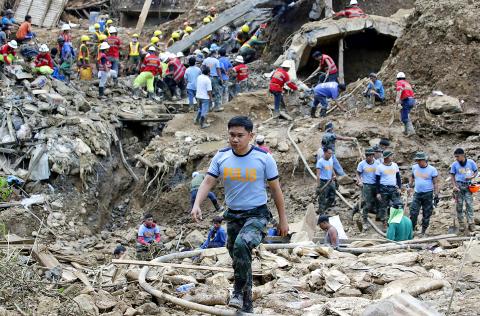A Philippine police officer who tried to persuade residents of a mining camp to move to safety as a powerful typhoon approached on Tuesday said they refused to leave and a day later the storm triggered a huge landslide that buried dozens of people.
Police Senior Inspector Heherson Zambale said in an interview that he was stunned after learning that the massive landslide had covered a chapel and bunkhouses in the mountain village where he and other officials had met with some of the victims a day before the tragedy struck on Saturday last week.
Typhoon Mangkhut, the most powerful storm to hit the Philippines this year, left at least 81 people dead and dozens of others missing, mostly in the avalanche in the gold-mining town of Itogon in Benguet province.

Photo: AP
The storm later blew on to Hong Kong and southern China, where it caused more deaths and damage.
Zambale said he and other local officials tried to convince the villagers, mostly small-scale miners and their families, to move to an evacuation center as the typhoon approached.
A villager officer who accompanied Zambale used a megaphone to warn people that Mangkhut was extraordinarily powerful and everybody should leave, he said.
The villagers told the police officer that they thought the chapel and nearby bunkhouses were on stable ground, and that they would only move away if the storm became severe, he said.
Zambale said he saw about 15 villagers outside the chapel and bunkhouses.
“Some were smiling and there were some who were just quiet. Some were listening to us,” he said.
Police photographs showed the officers in hard hats and light green raincoats talking with the villagers outside of what appears to be the concrete chapel and nearby bunkhouse, with piles of sandbags nearby.
Part of the mountain slope, covered in green foliage, can be seen behind the buildings.
Zambale, who has battled insurgents and criminals for eight years, said he had a bad feeling about the clearing where the buildings stood near a river, surrounded by tall mountains.
Some villagers heeded the warnings and left before the typhoon struck.
“But many were left behind,” Zambale said.
Rescuers have recovered 14 bodies from the avalanche and at least 58 other people remain missing, he said.
Itogon Mayor Victorio Palangdan on Monday said it was unlikely any of the missing were still alive, although rescuers continued to search.
Police Commander Rolando Nana said a special police unit scanned the landslide-hit area with radar that can detect heartbeats, but found no sign of life.
As more than 300 rescuers, including police and soldiers, used shovels and picks to search for the missing, Zambale said he still remembers the faces of the villagers he tried to convince to flee.
“I really feel sad, I cannot describe the emotion,” he said. “It’s not only the people who don’t listen. They have children, wives, elderly parents who will all suffer.”

DISPUTED WATERS: The Philippines accused China of building an artificial island on Sabina Shoal, while Beijing said Manila was trying to mislead the global community The Philippine Coast Guard (PCG) is committed to sustaining a presence in a disputed area of the South China Sea to ensure Beijing does not carry out reclamation activities at Sabina Shoal (Xianbin Reef), its spokesperson said yesterday. The PCG on Saturday said it had deployed a ship to Sabina Shoal, where it accused China of building an artificial island, amid an escalating maritime row, adding two other vessels were in rotational deployment in the area. Since the ship’s deployment in the middle of last month, the PCG said it had discovered piles of dead and crushed coral that had been dumped

Experts have long warned about the threat posed by artificial intelligence (AI) going rogue, but a new research paper suggests it is already happening. AI systems, designed to be honest, have developed a troubling skill for deception, from tricking human players in online games of world conquest to hiring humans to solve “prove-you’re-not-a-robot” tests, a team of researchers said in the journal Patterns on Friday. While such examples might appear trivial, the underlying issues they expose could soon carry serious real-world consequences, said first author Peter Park, a postdoctoral fellow at the Massachusetts Institute of Technology specializing in AI existential safety. “These

The most powerful solar storm in more than two decades struck Earth on Friday, triggering spectacular celestial light shows from Tasmania to the UK — and threatening possible disruptions to satellites and power grids as it persists into the weekend. The first of several coronal mass ejections (CMEs) — expulsions of plasma and magnetic fields from the sun — came just after 4pm GMT, according to the US National Oceanic and Atmospheric Administration’s Space Weather Prediction Center. It was later upgraded to an “extreme” geomagnetic storm — the first since the “Halloween Storms” of October 2003 caused blackouts in Sweden and damaged

Using virtual-reality (VR) headsets, students at a Hong Kong university travel to a pavilion above the clouds to watch an artificial intelligence (AI)-generated Albert Einstein explain game theory. The students are part of a course at the Hong Kong University of Science and Technology (HKUST) that is testing the use of “AI lecturers” as the AI revolution hits campuses around the world. The mass availability of tools such as ChatGPT has sparked optimism about new leaps in productivity and teaching, but also fears over cheating, plagiarism and the replacement of human instructors. Pan Hui (許彬), a professor of computer science who is leading